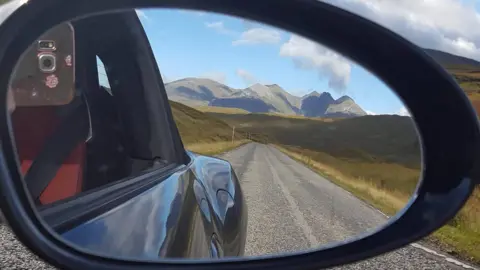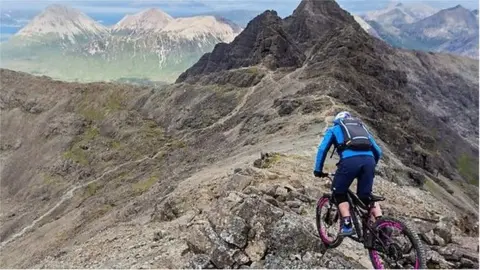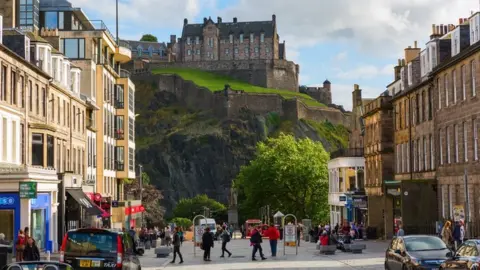Over here. Over crowded. Over the top?
- 'Over-tourism' is causing a political backlash from residents in parts of Europe where the numbers are felt to be excessive, with environmental harm as well as nuisance and a loss of local character.
- In Scotland, from Edinburgh to Skye and the North Coast 500 road, the pressure points are feeling the strain, and there are calls for better planning ahead if the numbers are to keep growing.
- The solutions may include tourist tax, managing demand and AirBnB, and smarter ticketing.
Is Scotland getting too much of a good thing? After several lacklustre years of tourism growth, numbers have surged in the past two years, and some hotspots are at risk of over-heating.
"Over-tourism"' is becoming a political issue in other European honeypots, including Majorca, Barcelona, Venice, Dubrovnik and Amsterdam. Measures are being taken to crack down on visitors' anti-social behaviour and on short-term letting, such as those through the AirBnB website.
Efforts are being made to limit crowd numbers, and to ensure that city centres retain their local character and content.
At its start in 1947, the Edinburgh Festival was run from August into early September, in a bid to extend the tourist season. It is now the peak of the tourist season and a world class event for world class visitor numbers. And that season now runs all year, peaking again at Hogmanay.
The North Coast 500 is the road round the far north and west of Scotland, given a new marketing brand. Quickly picked up by the travel media as a "must drive" experience, its success has been sensational.
 BBC Alba
BBC AlbaFor businesses along the route, the visitor season has suddenly gone from four months to nearly 10. But it has also brought pressure, where there has been inadequate capacity for accommodation, toilets and parking.
The Isle of Skye, offering spectacular photography, has also been a favourite of social media. Search online for Danny MacAskill, a Skye lad, stunt cycling along the Cuillin Ridge, and you'll find it's been viewed more than 58 million times in less than four years.
So the Isle of Skye has joined the world's bucket list. And on other islands, road-equivalent fares have helped to clog the constrained capacity of CalMac.
 BBC/Cut Media
BBC/Cut MediaShirley Spear, chair of Skye Connect, a new destination management organisation (bringing together tourist businesses with others who have an interest) says that there has been a lack of foresight about growing numbers and the need to plan for growth.
However, Prof John Lennon, a tourism expert at Glasgow Caledonian University, warns against turning negative about a highly positive boost to an industry of vital importance to Scotland's economy, exports and employment.
Dynamic pricing
So what can be done? Is the answer a tourist tax, as proposed in Edinburgh? Scotland's councils - with the City of Edinburgh in the lead - say it has to be part of the answer, with a plan to raise £11m a year, with a £1 nightly levy.
Others, including UK Hospitality, say the sector is already encumbered with some of Europe's highest taxes, starting with 20% VAT. And Prof Lennon warns against using tax as a driver of prices rather than revenue. There's no evidence of that displacing people from the hottest spots and times.
What about better management of AirBnB? Skye has more than 500 properties on the website, which is good for boosting capacity, particularly at peak times. But it cuts down the accommodation available for the lower-paid hotel, bar and restaurant workers who make tourism in remote locations possible.

AirBnB is where a city's residents often clash with visitors, staying - sometimes noisily - on tenement stairs that were not designed for that sort of co-habitation. Options on licensing, regulation, inspection and fairer taxation can be part of the response to that.
At VisitScotland, the government-funded agency for promoting and co-ordinating tourism effort, the wealth of data about individual visitors allows targeting of the high value, the festival-goers and the nature-seekers, to ensure they get the right messages about the wide range of options on offer. The message now: Scotland's not for everyone.
But targeting the big spenders is not as easy as it was. Nor is their behaviour as predictable. Prof Lennon points out that it's not that unusual for visitors to fly in by budget airline, stay at a five star resort with a gourmet meal, and the next night, they're in a cheap online rental, eating their evening meal out of an Aldi bag.
Ticketing can be part of the answer. Access to some parks and attractions in developing countries features dual pricing, with cheaper rates for local people.
The top cultural attractions in Amsterdam now require advance booking, as do big art exhibitions in London. So is dynamic pricing of attractions a solution, to discourage queues and improve the visitor experience?
 Getty Images
Getty ImagesAdvertisements on Edinburgh buses now advise visitors to book ahead for a visit to the city's castle. There are also moves to push people out from the most congested sites. How about Stirling Castle instead, Monsieur et Madame - a similar hill-top fortress, lots of history, only an hour away, much cheaper and a lot quieter?
I've been hearing from those who know and those who are experiencing the pressure of tourist numbers.
Among the lessons learned: Europe has big new pressure points, but some places have been dealing with travel surges for many years. In India, religious festivals can mean millions of people on the move, and all wanting to get to one spot for one auspicious moment. So there are lessons from around the world.
And Prof Harold Goodwin, an expert in tourism across poorer developing economies, goes so far as to suggest that Disneyland may be a useful model for future tourism, in that you pay a price that covers the cost of the attraction, and also the cost of clearing up after you've left.
